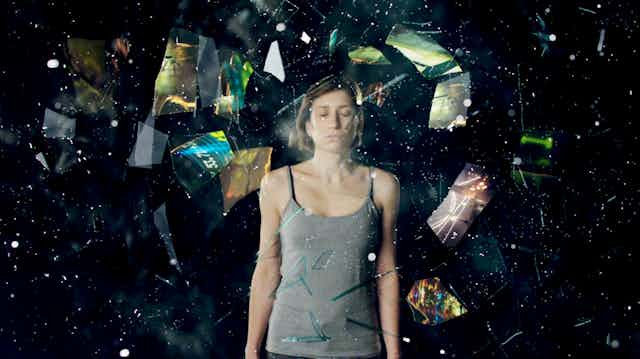How does it feel to be trafficked for sex? Dehumanised, broken and invisible: that’s what people who’ve been through it have told me. And it’s what I wanted to convey when I began creating a digital project called The Crossing in 2015, in collaboration with the producer Colin Burrows and patron Emma Thompson.
The Crossing tells the story of a trafficked girl told from a first person point of view, a fictionalised account based on a composite of girls’ experiences drawn from case study research for the project. It has been adapted to be displayed on multiple types of platform, from a single screen to a film with surround sound, and an interactive version.
The girl in the film hopes to make a better life for herself and ultimately make her family proud. Once trafficked, she is caught in a spiral of violence and abuse. Even when she escapes, she cannot go home because of the shame she feels she’s brought to her family. As one survivor described it during our research, it is like the “body being separated from the soul”.
The film gradually unfurls into an exploration of the trust created by some men’s use of the “lover boy” technique. These men use a number of tactics to isolate a victim from their families and communities, often using romance and the promise of a better life – often abroad. Once their victim is isolated, the men use violence, blackmail and threaten the girl’s family.
“Lover boys” exploit the hope, frustration and dreams of young people to fuel a multi-billion dollar trafficking industry. The technique – also known as the “boyfriend model” – was highlighted by police after a recent child sex exploitation trial in Newcastle.
‘Completely engulfed’
Though created for a wide audience, we have begun showing The Crossing to under 18-year-olds – those most vulnerable to the “lover-boy” techniques.
In 2016, we showed the multiscreen project via 13 interconnecting screens to a group of 20 teenagers in the Ruskin Digital Gallery in Cambridge. The group, aged 14 and 15, were asked if they could identify with any elements of this story. One girl said: “I feel like it would be tempting to follow the ‘lover boy’”, while another said she could understand “wanting more to do and risking things for a chance at something better.”
The visual images in the film represent narrative elements or fragments of the girl’s story – depicting her invisibility in a city where life carried on around her. It was filmed using slow motion techniques, drones and projections to create a sense of heightened reality that places the viewer within the girl’s body. The students were given bluetooth headphones to personalise their experience within the gallery – listening to a soundscape underpinned by the girl’s breathing. This created an intense and at times disturbing response from the teenagers.
“What struck me was the impact of the sound, putting somebody in the mind and body of someone who is trafficked,” one boy said. “I felt as if her heartbeat was mine. I felt completely engulfed,” said one girl, while another described it as feeling “very personal, like she was talking to me.”

Beware of ‘lover boys’
It can be very difficult to know the impact of films such as these, but some of the responses we got showed how it had it opened the mind of these teenagers mind to the dangers of trafficking and exploitation. “I didn’t think people went willingly,” one girl explained, “and I thought it was all people getting shoved into unmarked vans and sold off.” Another girl said: “The film made me feel extremely angry, frustrated, sad and disgusted. Also a small sense of relief that this issue is being recognised and there are people to help. But annoyed that it goes under the radar so easily.”
One of the most striking responses from these young people to the audiovisual experience came from a boy of 15:
The most powerful elements for me were the images of the girl with her clothes off. It made me uncomfortable as usually it would be attractive but given the circumstances, it was just wrong.
The film was shortlisted for AHRC Best Research Film of the Year 2016, and an interactive version is now being developed to help show young people how and why it was made. We’re also working with local schools in Cambridge to deliver the project as part of their studies in the coming months.

